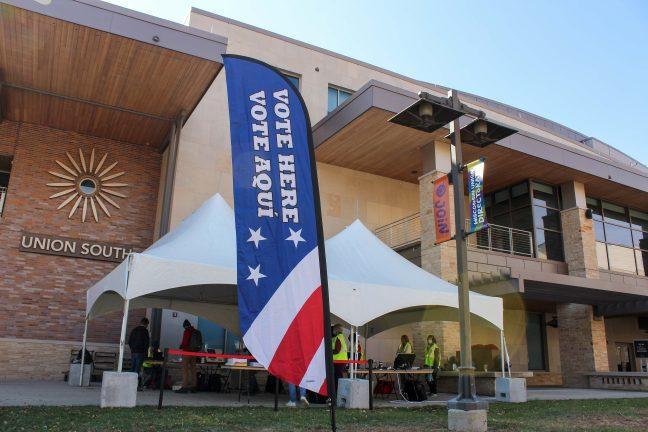Wisconsin saw a high voter turnout in the weeks leading up to Election Day as more voters choose early absentee mail and in-person voting options.
Multiple communities reached 50% or higher for total voter turnout for the 2016 presidential election, many of them within Milwaukee and Dane County. Middleton hit nearly 60% of its 2016 voter count while Shorewood Hills, a community near the University of Wisconsin, reached two-thirds as of Oct. 16.
In Wisconsin, voters requested 1.57 million absentee ballots and returned about 1,130,940, according to Madison Elections Division Administrator Meagan Wolfe in an Oct. 22 media conference. The returned number also includes about 149,846 in-person absentee ballots.
Early in-person voting began two weeks prior to election day on Oct. 20. Voting tents were set up at UW, Madison College and Edgewood College.
Increased early voting levels will change poll worker duties on election day. While absentee ballots and early-voting can be done prior to Nov. 30, all ballots are legally mandated to be counted on election day.
These levels contrast the around 800,000 absentee ballots cast in the 2016 presidential election. Wolfe said this change may strain ballot-counting efforts and poll workers.
“The increased number of absentee ballots means that on election day our polling places are really doing double-duty, because they can’t start opening and tallying those absentee ballots until polls open on election day,” Wolfe said in the conference. “In many ways, our communities need more poll workers than they have before.”
Concerns about the number of poll workers needed to accommodate more absentee ballots on election night emerged — roughly 50 Wisconsin municipalities faced shortages as of Oct. 16, with the number climbing to 70 on the myVote list as of Oct. 24.
Despite these shortages, many college-aged students volunteered for poll worker positions, according to Isthmus. This helped fill in the gap of COVID-19 susceptible older populations who typically work at the polls on a normal election year.
Some Wisconsin cities like Madison are more prepared for election day than in previous years. Madison Deputy City Clerk Jim Verbick said the city has more poll workers than usual.
“Normally we have about 3,000 poll workers, right now we have 6,000 poll workers,” Verbick said. “We are in a very good position. We’ve actually been having to turn down additional poll workers in the last month or so.”
A large influx of volunteers also requires more training which includes COVID-19 prevention information. Middleton City Clerk Lorie Burns said these precautions forced the city to prepare more for election day.
“We have had a tremendous amount of support from volunteers but that entails extra training of new workers,” Burns said. “We have also had to plan for and provide for safe social distancing and PPE to keep all workers and voters safe.”
The shift to more absentee and early voting also raised concerns about election interference. U.S. Director of National Intelligence John Ratcliffe warned Americans in a press conference on Oct. 22 Iran and Russia obtained voting data which could be used to falsely communicate information to voters.
This security development came a day after registered Democratic voters in Florida reported receiving threatening emails which demanded them to vote for Donald Trump, according to ABC News. These cases have since been investigated by local sheriff offices and the FBI.
Wolfe said though there is no evidence suggesting Wisconsin voting systems have been compromised in any clear way, disinformation groups have started trying to confuse voters. She said Wisconsinites must consult reliable sources for election information.
“Yesterday’s announcement serves as a reminder to all of us as we head into the election to seek out trusted sources of election information. That’s your state or local election official,” Wolfe said.
Data shows absentee and early voting is largely democratic. President Donald Trump repeatedly attacked mail-in voting, calling it “a disaster” and “a fraud” in the first presidential debate on Sept. 29, leading various GOP operatives to oppose certain voting options during the pandemic.
Republicans saw voter registration gains in battleground states like Florida, North Carolina and Pennsylvania which could provide hope for Trump’s reelection, according to the New York Times.
Predictions show Wisconsin will act as a swing state this election year, meaning it has a similar likelihood of voting largely blue or red. Wisconsin traditionally has a large mix of Republican and Democratic voters with both large urban centers like Milwaukee and smaller rural towns.
“Our voters are very civically engaged. We look forward to seeing our voters turn out and vote however they wish,” Verbick said.


